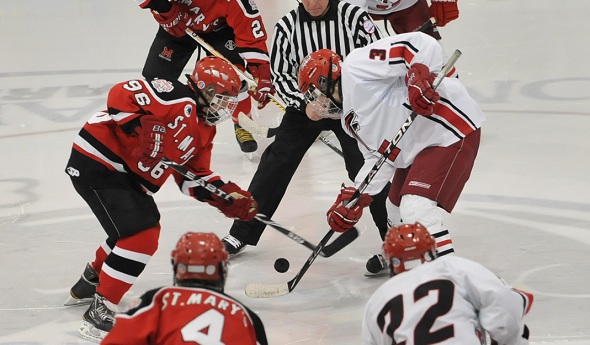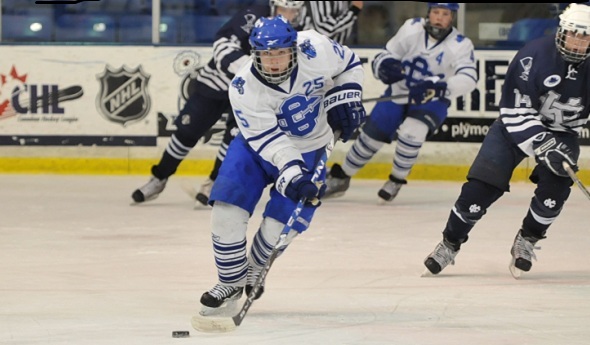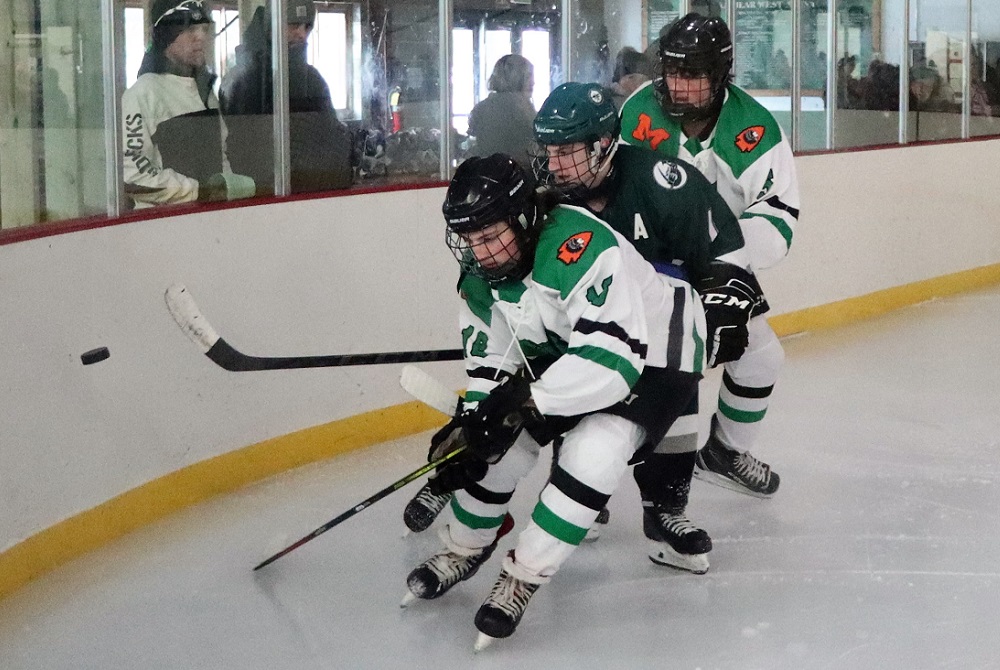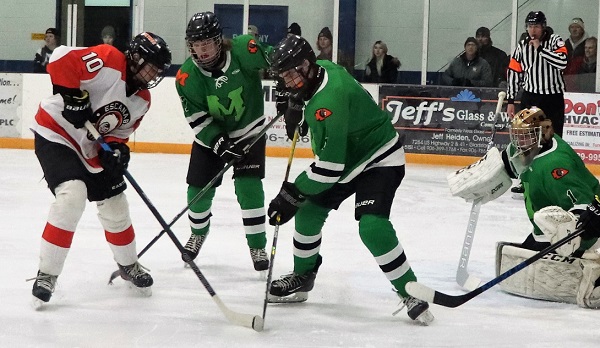
Finals Face-Off at Compuware Arena
March 7, 2012
The ice has disappeared from the hometowns of this weekend's Division 2 Ice Hockey Semifinalists.
But the best hockey action of the season will take place beginning today at Plymouth's Compuware Arena.
Below are team-by-team glances of all four teams contending for the MHSAA Division 2 championships. Those teams face off Thursday. Division 1 and 3 Semifinalists will be added after Wednesday's Quarterfinals, and play their Semifinals on Friday. All championship games are Saturday.
All Semifinals and the Division 1 Final will be streamed live at FoxSportsDetroit.com and MHSAA.tv. The Division 3 and 2 Finals will be broadcast live on Fox Sports Detroit Plus channels, with all nine games archived at MHSAA.tv.
Match-ups are as follows:
Division 2 Semifinals - Today
Forest Hills Eastern (22-6) vs. Birmingham Brother Rice (23-4-1) - 5 p.m.
Grosse Pointe South (21-5-1) vs. Port Huron Northern (17-10-1) - 7:30 p.m.
Division 3 Semifinals - Friday, March 9
Grosse Pte. Woods U. Liggett (25-3) vs. Chelsea (21-4-2) - Noon
Houghton (23-4) vs. Grand Rapids Catholic Central (19-7-2) - 2:30 p.m.
Division 1 Semifinals - Friday, March 9
Brighton (22-4-2) vs. Orchard Lake St. Mary's (17-10) - 6 p.m.
East Kentwood (19-9) vs. Grosse Pointe North (14-14) - 8:30 p.m.
FINALS - March 10 - Compuware Arena, Plymouth
Division 2 – 10 a.m.
Division 3 – 2 p.m.
Division 1 – 6 p.m.
Click for a full schedule of this weekend's games plus full results as they come in. Players statistics below are through the Regional round (Orchard Lake St. Mary's are through the Quarterfinal).
Division 1
BRIGHTON
Record/rank: 22-4-2, No. 3
Championship history: One MHSAA title (2006).
Coach: Paul Moggach, 17th season (300-110-36)
League finish: First in Kensington Lakes Activities Association
Best wins: 5-3 over No. 5 Novi, 9-4 over East Kentwood, 5-1 over No. 8 Howell (Regional Semifinal), 3-1 over Division 2 No. 6 Midland.
Players to watch: Scott Schueneman, senior left wing (26 goals, 16 assists); Mitch Kahl, senior center (12 goals, 24 assists); Tommy Kivisto, senior center (14 goals, 33 assists).
Outlook: After two down seasons (relatively speaking), the Bulldogs won their first league title since 2009 and first District and Regional since 2006. Brighton closed the regular season with that win over co-Semifinalist East Kentwood before rushing through its four postseason opponents by a combined score of 19-2. Nine players had at least 10 assists coming into this week.
EAST KENTWOOD
Record/rank: 19-9, unranked
Championship history: One MHSAA title (1993), three runner-up finishes.
Coach: Todd Bell, fifth season (70-60-5)
League finish: First in O-K Tier 2
Best wins: 4-3 over Grand Rapids Kenowa Hills, 2-1 over Division 3 No. 6 Grand Rapids Catholic Central
Players to watch: Brett White, senior center; Erik Stapleton, senior left wing (stats not available).
Outlook: White was an all-state first-team selection and Stapleton a second-teamer as East Kentwood advanced to the Semifinals last season as well. East Kentwood has dominated throughout the postseason, winning its four games by a combined score of 35-7, and fell to some top competition during the regular season with four losses to ranked teams.
GROSSE POINTE NORTH
Record/rank: 14-14, No. 6
Championship history: Two MHSAA titles (most recently 2002 Division 2), one runner-up finish.
Coach: Scott Lock, 14th season (record N/A)
League finish: Seventh in Michigan Interscholastic Hockey League
Best wins: 3-0 over No. 4 Livonia Churchill (Quarterfinal), 4-2 over Division 2 No. 4 Grosse Pointe South, 1-0 and 5-0 over Division 2 No. 9 Warren DeLaSalle, 6-1 over Division 2 No. 5 Marquette, 2-1 over Division 2 No. 2 Trenton, 5-1 over Division 2 No. 3 Port Huron Northern.
Players to watch: Brad Werenski, junior center (11 goals, 12 assists); Joe Aluia, senior right wing (15 goals, 13 assists); John Paul Lucchese, senior right wing (14 goals, 16 assists).
Outlook: Grosse Pointe North entered the postseason four games under .500 but got even again with its fifth-straight win in the Quarterfinal. But the Norsemen have seen most of the best, with wins over half the top-10 teams in Divsion 2 and 12 losses against teams ranked in one of the three divisions. Senior goaltender Chip Wujek has posted two of his five shutouts in the last four games.
ORCHARD LAKE ST. MARY
Record/rank: 17-10, No. 2
Championship history: Three MHSAA titles (most recently 2008), one runner-up finish.
Coach: Brian Klanow, 12th season (216-95-25)
League finish: Fifth in Michigan Interscholastic Hockey League
Best wins: 3-1 and 4-0 over No. 6 Grosse Pointe North, 4-1 over No. 7 Utica Eisenhower (Quarterfinal), 2-1 over Division 2 No. 9 Warren DeLaSalle, 5-4 over Division 2 No. 1 Birmingham Brother Rice, 5-2 over Division 2 No. 2 Trenton, 3-1 and 4-1 over Division 2 No. 3 Port Huron Northern, 4-1 over Division 3 No. 1 Bloomfield Hills Cranbrook Kingswood.
Players to watch: Shane Bednard, senior center (12 goals, 19 assists); Luke Rodgers, senior right wing (17 goals, 10 assists), Cody Milan, sophomore center (six goals, 17 assists).
Outlook: The Eaglets' list of impressive wins includes one each against the top-ranked teams from both Division 2 and 3; those two teams also beat St. Mary once, and Division 1 top-ranked Detroit Catholic Central beat OLSM three times. But the Shamrocks are out of the tournament and the Eaglets are still in and finished runner-up last season. St. Mary also boasts a couple of sharp left wings in sophomore Mitchell Vanderburg (16 goals, nine assists) and junior Cooper Anstett (10 goals, 16 assists).
Division 2
BIRMINGHAM BROTHER RICE
Record/rank: 23-4-1, No. 1
Championship history: Two MHSAA titles (most recently 2005), two runner-up finishes.
Coach: Lou Schmidt, Jr., ninth season (156-77-15)
League finish: Tied for second in Michigan Interscholastic Hockey League
Best wins: 10-4 over No. 3 Port Huron Northern, 4-1 over Division 1 No. 2 Orchard Lake St. Mary, 2-1 and 4-3 over Division 3 No. 1 Bloomfield Hills Cranbrook-Kingswood.
Players to watch: Chris Wilberding, senior defenseman (10 goals, 29 assists); Thomas Ebbing, junior center (23 goals, 38 assists); Mackenzie MacEachern, senior right wing (37 goals, 42 assists).
Outlook: Last season’s runner-up is the favorite this time. Brother Rice’s losses were to Division 1 top-two teams Detroit Catholic Central (twice) and Orchard Lake St. Mary, and Division 2 No. 2 Trenton. The Warriors have outscored opponents 156-61, with six players scoring at least 10 goals this season. Sophomore goaltender Jack Bowman has a 1.93 goals-against average.
GRAND RAPIDS FOREST HILLS NORTHERN/EASTERN
Record/rank: 22-6, No. 10
Championship history: Has not appeared in an MHSAA Final.
Coach: Todd Gallup, third season (59-22-1)
League finish: Second in O-K Tier 1
Best wins: 4-3 over East Kentwood, 5-4 over No. 7 Traverse City Central (Quarterfinal).
Players to watch: Chris Hollemans, senior defenseman (eight goals, 25 assists); Sam Rennaker, junior center (31 goals, 18 assists); Brad Reitter, junior right wing (18 goals, 30 assists).
Outlook: Forest Hills Northern/Eastern has outscored its four postseason opponents by a combined score of 17-7, and all opponents 114-67 this season. Although Rennaker and Reiter had scored 45 percent of the team’s goals heading into this week, seven players had at least 10 assists. The Huskies/Hawks are 17-2 over their last 19 games.
GROSSE POINTE SOUTH
Record/rank: 21-5-1, No. 4
Championship history: One MHSAA title (2007), one runner-up finish.
Coach: James Bufalino, third season (45-25-7)
League finish: First in Michigan Metro High School Hockey League
Best wins: 5-3 over No. 6 Midland, 2-1 over No. 7 Traverse City Central, 3-1 over No. 9 Warren DeLaSalle, 3-1 over No. 2 Trenton (Quarterfinal).
Players to watch: Cameron Gibson, senior right wing (22 goals, 10 assists); Wesley Cimmarrusti, senior center (16 goals, 21 assists); Nolan Monforton, senior right wing (14 goals, 20 assists).
Outlook: Grosse Pointe South hasn’t lost in 18 games (one tie) after starting 1-4 this winter. Although offense has provided arguably the biggest push – the Blue Devils have averaged 5.6 goals per game since the early struggle – senior goaltender Christopher Schebil has been solid as well with a 1.78 goals-against average and four shutouts entering this week. Eight Grosse Pointe South players had at least 10 goals this season heading into Tuesday’s 11-goal showing.
PORT HURON NORTHERN
Record/rank: 17-10-1, No. 3
Championship history: Division 1 runner-up in 2001.
Coach: Daryel McCarrel, 359-201-44
League finish: Sixth in Michigan Interscholastic Hockey League
Best wins: 5-3 and 6-1 over No. 9 Warren DeLaSalle, 3-2 over Division 1 No. 2 Orchard Lake St. Mary, 6-2 over Division 3 No. 8 Sault Ste. Marie.
Players to watch: Bryce VanHorn, sophomore right wing (17 goals, 16 assists); Bobby King, junior left wing (16 goals, 17 assists).
Outlook: Port Huron Northern’s record might not glisten like some of the others – especially considering its 7-10-1 finish in its league. But the Huskies played 14 of their 24 regular-season games against ranked teams, and are riding a 7-1-1 streak. Only four players had at least 10 goals coming into this week – but seven had at least 10 assists. McCarrel moved into 11th in MHSAA history for hockey coaching wins this season.
Division 3
CHELSEA
Record/rank: 21-4-2, No. 7
Championship history: Has not appeared in an MHSAA Final.
Coach: Don Wright, 12th season (189-101-26)
League finish: First in Southeastern Conference
Best wins: 6-5 and 4-1 (Quarterfinal) over No. 10 Jackson Lumen Christi, 6-3 over Division 2 No. 8 Brownstown Woodhaven, 4-3 over Division 1 No. 10 Lake Orion.
Players to watch: Taylor Atchley, junior center (20 goals, 17 assists); Jacob Ryan, junior right wing (13 goals, 28 assists); Joe Hewitt, senior right wing (22 goals, 21 assists).
Outlook: Chelsea is an offensive powerhouse averaging 5.4 goals per game this season. Senior left wing Brad Hepler and senior center Kyle Whipple both had 34 points apiece heading into this week, and total the team had seven players with at least 10 goals -- and have scored a total of 145. Wright led the team to its fifth-straight league title, and this will be the Bulldogs' second Semifinal appearance in three seasons.
GRAND RAPIDS CATHOLIC CENTRAL
Record/rank: 19-7-2, No. 6
Championship history: One MHSAA title (2011), two runner-up finishes.
Coach: Mike Slobodnik, second season (44-13-2)
League finish: First in O-K Tier 1
Best wins: 4-0 and 4-1 over Division 2 No. 10 Forest Hills Northern/Eastern, 3-0 over Division 1 No. 10 Lake Orion.
Players to watch: Donald Sund, senior center (33 goals, 22 assists); Owen Kane, senior center (12 goals, 15 assists); Remy Woods, sophomore forward (11 goals, 12 assists).
Outlook: Sund and Kane were among the heroes from last season's MHSAA championship win; Sund had the team's first three goals and Kane had three assists in the 7-2 victory over Calumet in the Final. So although the Cougars have seven losses, it's impossible to look past them. Those losses came to either higher-ranked teams or much bigger schools, and GRCC has seven shutouts -- including two in its last four games.
GROSSE POINTE WOODS UNIVERSITY LIGGETT
Record/rank: 24-3, No. 3
Championship history: Two MHSAA titles (most recently 1990).
Coach: Robb McIntyre, fourth season (75-27-1)
League finish: Does not play in a league.
Best wins: 5-3 over No. 10 Jackson Lumen Christi, 4-2 over No. 9 Sault Ste. Marie, 8-3 and 4-0 (Quarterfinal) over No. 8 Marysville, 5-0 over No. 6 Grand Rapids Catholic Central, 8-1 over No. 5 Dearborn Divine Child (Regional Final), 5-2 over Division 4 Grosse Pointe South
Players to watch: Jacob Soyka, junior center (25 goals, 33 assists); James Counsman, junior left wing (33 goals, 24 assists); Mark Evan Auk, junior defenseman (33 goals, 37 assists).
Outlook: University Liggett is the highest-ranked team left in Division 3 and has beaten five of the top 10 in part because of an offense averaging 5.8 goals per game with 12 players tallying at least 10 assists heading into the week. The Knights have outscored their four postseason opponents by a combined score of 33-4. Those losses came to Division 1 No. 7 Utica Eisenhower, Division 2 No. 8 Brownstown Woodhaven and Hartland.
HOUGHTON
Record/rank: 23-4, No. 4
Championship history: One MHSAA title (1982), two runner-up finishes.
Coach: Corey Markham, 13th season (172-123-14)
League finish: First in Lake Superior Hockey Conference
Best wins: 2-1 over No. 8 Sault Ste. Marie, 5-2 over No. 5 Dearborn Divine Child, 5-1 over No. 2 Calumet (Regional Final), 2-1 over Division 2 No. 5 Marquette.
Players to watch: Connor Hannon, sophomore center (17 goals, 21 assists); Ray Brice, sophomore left wing (20 goals, 14 assists); Trevor Mattson, senior center (16 goals, 16 assists).
Outlook: This is the third time in 11 seasons that Houghton has made it to the season's final week -- the Gremlins lost by a goal the first two times, including in a 2002 Division 2 Semifinal. Mattson centers a powerful line with sophomore left wing Jed Kallio (31 points entering the week) and senior right wing Aaron Kolehmainen (32 points). Markham also coaches the Houghton girls golf team, which won the MHSAA Division 1 Upper Peninsula championship last spring.


Manistique Hockey Co-Op Off to Successful Debut
By
John Vrancic
Special for MHSAA.com
February 4, 2022
MANISTIQUE — There’s a new kid on the block in Upper Peninsula high school hockey this season.
 The Manistique Emeralds, who launched a co-op program for the first time, already have made some noise while posting a 5-4-1 record through their first 10 games.
The Manistique Emeralds, who launched a co-op program for the first time, already have made some noise while posting a 5-4-1 record through their first 10 games.
Manistique is fresh from a 2-1 triumph over Painesdale Jeffers on home ice Saturday.
Also included in the co-op venture are Newberry, Munising and Eben Junction Superior Central.
“It feels great to have a high school program here,” said Manistique junior forward Carter Miller. “This is a big change from house league hockey. The high school game is a lot faster. This has been a pretty big transition. We had to get in shape faster and start a little earlier.”
The victory ended a two-game losing streak for the Emeralds, who dropped a 6-5 overtime decision to Escanaba on Friday and absorbed a 2-1 loss to Kingsford at Iron Mountain Jan. 25.
“It was a very exciting game last night,” coach John Nutkins said after Saturday’s game. “We trailed by three goals twice and took them into overtime. I think that gave us a lot of momentum for the rest of the season. We outplayed Kingsford, but had trouble putting the puck in the net. The guys are pulling together. We have to keep working and improving. We feel we’re in a stretch where we can win some games.”
The Emeralds travel to the Copper Country this weekend to face Negaunee on Friday and Jeffers on Saturday at Michigan Tech.
“They (Negaunee) don’t have a lot of guys, but they take quick shots,” said sophomore goaltender Alex Noble. “We just have to put pressure on the puck.
 “(Defeating Jeffers) is a big W for us. I think this will give us momentum going into next weekend. We’ve been in a lot of close games. We didn’t give up against Esky. That was a real big game for us.”
“(Defeating Jeffers) is a big W for us. I think this will give us momentum going into next weekend. We’ve been in a lot of close games. We didn’t give up against Esky. That was a real big game for us.”
Dakota Maki, a senior forward from Superior Central, put the Emeralds on the board first in a 6-1 road loss to Escanaba.
“That’s definitely not a game we want to remember,” said Nutkins. “Although, it was exciting to get the early goal. They have a great hockey program, but I don’t think that’s who we are. It’s always kind of a feeling out process. In the first game at Iron Mountain they (Kingsford) were flying. It was kind of a culture shock. I feel we’ve improved a lot from the beginning of the season.”
Manistique dropped a 1-0 decision to the Flivvers on Nov. 18, then tied with Jeffers 1-1 and beat the Hancock jayvees 2-0 at MTU at the start of December.
The Emeralds followed that with a 7-3 triumph over Kingsford in their home debut Dec. 16.
“That was definitely exciting,” said Gavin Nutkins, a sophomore forward from Newberry. “There were more than 300 people here. I’ve never experienced that before. The fans have supported us very well. I think we’ve done very well. We are just getting into game shape, and it’s starting to show.”
Noble stopped 26 shots in Saturday’s victory over Jeffers.
“This is a big step up,” he said. “We just have to work hard for it. This is a bit stronger competition and a faster game.”
Gavin Nutkins said he got interested in hockey at a very young age.
“I played baseball and football, but nothing compares with hockey,” he added. “It’s really hard with school. My dad’s the coach, which makes it a little easier. It’s about an hour’s drive both ways. We usually get home about 9:30 or 10 p.m., then I have to study for 2-3 hours, get about six hours of sleep and go to school. Sometimes you get a little tired.”
 John Vrancic has covered high school sports in the Upper Peninsula since joining the Escanaba Daily Press staff in 1985. He is known most prominently across the peninsula for his extensive coverage of cross country and track & field that frequently appears in newspapers from the Wisconsin border to Lake Huron. He received the James Trethewey Award for Distinguished Service in 2015 from the Upper Peninsula Sportswriters and Sportscasters Association.
John Vrancic has covered high school sports in the Upper Peninsula since joining the Escanaba Daily Press staff in 1985. He is known most prominently across the peninsula for his extensive coverage of cross country and track & field that frequently appears in newspapers from the Wisconsin border to Lake Huron. He received the James Trethewey Award for Distinguished Service in 2015 from the Upper Peninsula Sportswriters and Sportscasters Association.
PHOTOS (Top) Manistique attempts to maintain possession against Painesdale Jeffers. (Middle) The Emeralds defend in front of their goal against Escanaba last month. (Photos by Veronica Edwards.)

